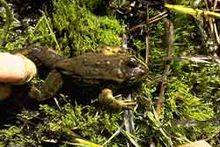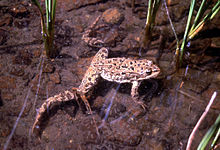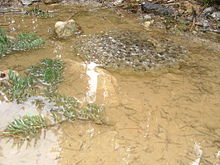- Columbia Spotted Frog
-
Columbia Spotted Frog 
Conservation status Scientific classification Kingdom: Animalia Phylum: Chordata Class: Amphibia Order: Anura Family: Ranidae Genus: Rana Species: R. luteiventris Binomial name Rana luteiventris
Thompson, 1913Synonyms Rana pretiosa luteiventris Thompson, 1913
The Columbia Spotted Frog, Rana luteiventris, is a North American species of frog. It is green to brown in color with spots on the dorsal surface. The belly and upper lip are white in color. Individuals can be distinguished from other Rana species by their shorter back legs, narrow snout and upturned eyes. Since they spend most of their time in the water, they also have more webbing in their hind feet than similar species. Although unthreatened, this animal has been studied as a model species for the effects of habitat fragmentation.
Contents
Taxonomy
Rana is a genus of frogs. Some common species associated with this genus are the Cascades Frog, Foothill Yellow-legged Frog, and the Moor Frog. Frogs of this genus are found throughout much of the world including Europe, Asia, North America, Central America, and South America.
Description
Adult Frog
The Columbia Spotted Frog is a medium sized frog reaching lengths of up to three and a half inches (90 mm). Its color ranges from a dark, olive green to light brown with irregularly-shaped black spots on its back and legs (rendering its name). Its skin texture follows suite with the rest of the Rana genus. It varies from a rough texture to a smooth texture that couple with small folds of skin along their backs. This frog inhibits a unique feature regarding its color. It has a light-colored strip that runs along the upper lip. The ventral sides of the frog are usually colored either pink or yellow but only in the adult form.
This frog is well-noted by a few of its physical characteristics as well. The frog inhibits a long, narrow snout and upturned eyes. The spotted frog is known as a very aquatic amphibian because the webbing on its feet extends all the way to the end of its longest toe. When comparing this frog to others of the same size, such as the Northern Leopard frog, it tends to have shorter hind legs.
Tadpoles
Columbia Spotted Frog tadpoles are brownish-green in color. This color runs dorsally along the tadpole. Gold spots are also intermittent throughout this coloring. The tadpoles have upturned eyes that are inset. They usually reach around 3.1 inches (80 mm) in length before beginning through journey to adulthood.
Habitat
Geographical location
The Columbia Spotted Frog is widespread throughout North America. These frogs can be found from Alaska and parts of British Columbia to Washington, Idaho, and parts of Wyoming, Nevada, and Utah.
Habitat
The Columbia Spotted Frog is, like most other frogs, fairly aquatic. This means that their habitats are found generally near permanent bodies of water, which can include lakes, ponds, slow-moving streams, and marshes. The Spotted Frogs were found to need specific habitat characteristics within the prior-listed broader habitat characteristics. Adult spotted frogs inhabit mostly seasonally-flooded sites. This means that these frogs are more likely to be found at sites where there is a constant water source, but at certain times of the year the source increases exponentially in both the amount and level of water available.
Vegetation needs
These frogs are a constant victim to predation, which means that they need to be in an area with an abundant source of low-growing vegetation. A large part of this vegetation is usually submerged meaning that there are plants growing under the water or partly under the water. This vegetation includes many forms of algae and other aquatic plants. The Spotted Frog does not usually inhabit areas where there are large amounts of grasses and sagebrush growing. These plants are not as aquatic as their algae cousins. This makes them a bad hiding place for the spotted frog, since the frog is mostly aquatic. This is a primary reason for the habitat to require such low-growing, submerged, aquatic plants. The Columbia Spotted Frog rarely ventures outside of these areas characterized by the above details. However, when it is time for the spotted frog to breed, they have been known to travel outside of these areas.
Reproduction
Area
The Columbia Spotted Frog reproduces similarly to other amphibians, but with a few unique details added. Columbia Spotted Frogs need to reproduce in areas where emergent vegetation is present. Two of the favorite types of vegetation for reproducin are reed canary grasses and cattails. The spotted frog reproduces in the same types of areas as it lives- ponds, slow-moving streams, and lakes.
Male
The males arrive at the breeding grounds before the females. They then present to the females a chorus (type of song) to try and attract a female for mating. This song ranges from a series of clicks to long, glottal sounds. This frog has an unusual characteristic of its reproduction. The male frog arrives at the breeding grounds before the female and establishes the oviposition site before the females become reproductively active. The oviposition is the site at which the eggs will be laid.
Female
Once the oviposition site is created, the female then begins to lay her eggs in shallow water. The male then fertilizes the eggs. The egg masses are fairly large in size ranging from zero all the way up to thirteen hundred eggs. The egg masses, once laid, absorb water and become the size of a softball. These eggs are not attached to any type of vegetation but are left free floating in said permanent water source. Soon after, the eggs hatch into little Columbia Spotted Frog tadpoles.
Breeding times
The Columbia Spotted Frog's breeding schedule depends heavily on its geographical location and the elevation at which it is at currently. In British Columbia, the frog will breed during February at sea level. In areas around Utah, the frog will breed around mid-March at an elevation of approximately 1,395 m (4,577 ft). At areas around that of Wyoming, the frog will reproduce from May through June at approximately an elevation of 2,377 m (7,799 ft). The female Columbia Spotted Frog will breed yearly at lower elevations and about every two to three years at higher elevations.
Diet
This frog is opportunistic at best. It will eat a variety of insects including grasshoppers, ants, wasps, beetles, and moths. These insects comprise more than fifty percent of the frog's diet. This frog will also eat seemingly unusual animals such as crustaceans, mollusks, arthropods, and arachnids.
In addition to being an insectivore, the Columbia Spotted Frog will eat such vegetation as algae, organic debris, a variety of plants, and other smaller water-dwelling organisms.
References
- Cossel Jr., John (1997): Rana luteiventris, Idaho Museum of Natural History. Accessed March 10, 2006
- Hammerson, Geoffrey (2004). "Rana luteiventris". IUCN Red List of Threatened Species. Version 3.1. International Union for Conservation of Nature. http://www.iucnredlist.org/apps/redlist/details/58649. Retrieved 12 May 2006.
- Hillis, D. M. & T. P. Wilcox (2005): "Phylogeny of the New World true frogs (Rana)." Molecular Phylogenetics and Evolution 34 (2): 299–314. doi:10.1016/j.ympev.2004.10.007 PMID 15619443 PDF fulltext.
- Hillis, D. M. (2007): "Constraints in naming parts of the Tree of Life." Molecular Phylogenetics and Evolution 42 (2): 331–338. doi:10.1016/j.ympev.2006.08.001 PMID 16997582.
- Munger, James, et al. (2008): "U.S. National Wetland Inventory Classifications as Predictors of the Occurrence of Columbia Spotted Frogs (Rana luteiventris) and Pacific Treefrogs (Hylaregilla)." Conservation Biology 12 (2): 320–330. JSTOR 2387502 doi:10.1111/j.1523-1739.1998.97012.x.
- Davis, Abbey and Paul Verrell (2005): "Demography and Reproductive Ecology of the Columbia Spotted Frog (Rana luteiventris) across the Palouse." Canadian Journal of Zoology 83 (5): 702–711. doi:10.1139/z05-061.
- Reaser, Jamie K. (2000): "Demographic Analysis of the Columbia Spotted Frog (Rana luteiventris): Case Study in Spatiotemporal Variation." Canadian Journal of Zoology 78 (7): 1158–1167. doi:10.1139/z00-043.
- Cossel, John, Groves, Charles Peterson, Ean Harker, Stephen Burton, Mike Legler, "Rana luteiventris." 2000. 21 Apr 2009.
External links
- Rana luteiventris at CalPhotos
- Rana luteiventris - Columbia Spotted Frog Information Page
- Amphiaweb
- Oregon Department of Fish and Wildlife Information and Conservation
- Wyoming Game and Fish Information and Conservation
- Utah Division of Wildlife Resources Information and Conservation
- Fish and Wildlife Branch- British Columbia Information and Conservation
- Columbia Spotted Frog recordings
Categories:- IUCN Red List least concern species
- Rana
- Animals described in 1913
Wikimedia Foundation. 2010.




